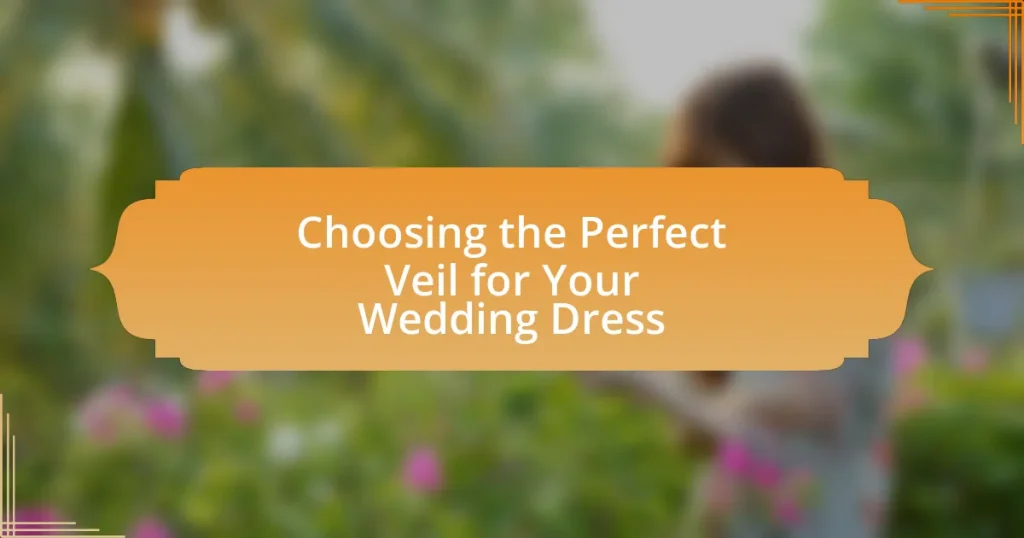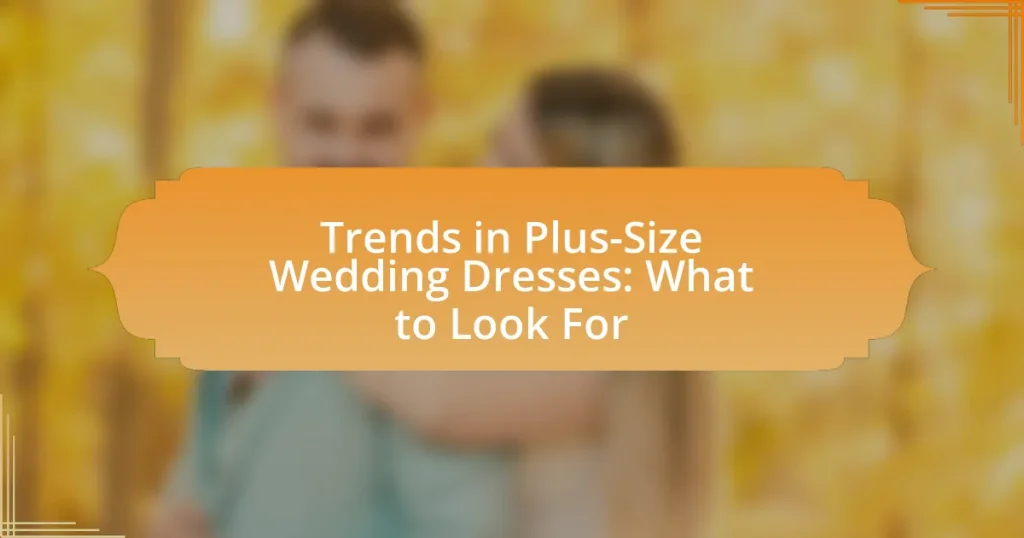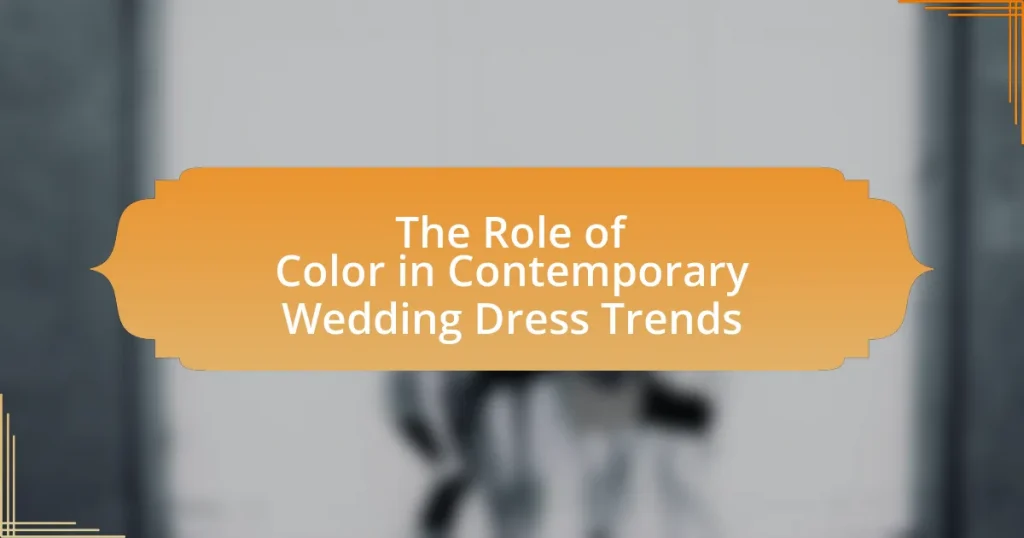Choosing the perfect veil for your wedding dress involves careful consideration of style, length, and fabric to ensure a harmonious look. The article outlines how the style of the wedding dress influences veil selection, detailing various dress styles and their ideal veil lengths. It also discusses the importance of fabric compatibility between the dress and veil, the different types of veils available, and how to personalize a veil with unique embellishments or family heirlooms. Additionally, practical tips for ensuring comfort, functionality, and avoiding common mistakes in veil selection are provided, making it a comprehensive guide for brides-to-be.
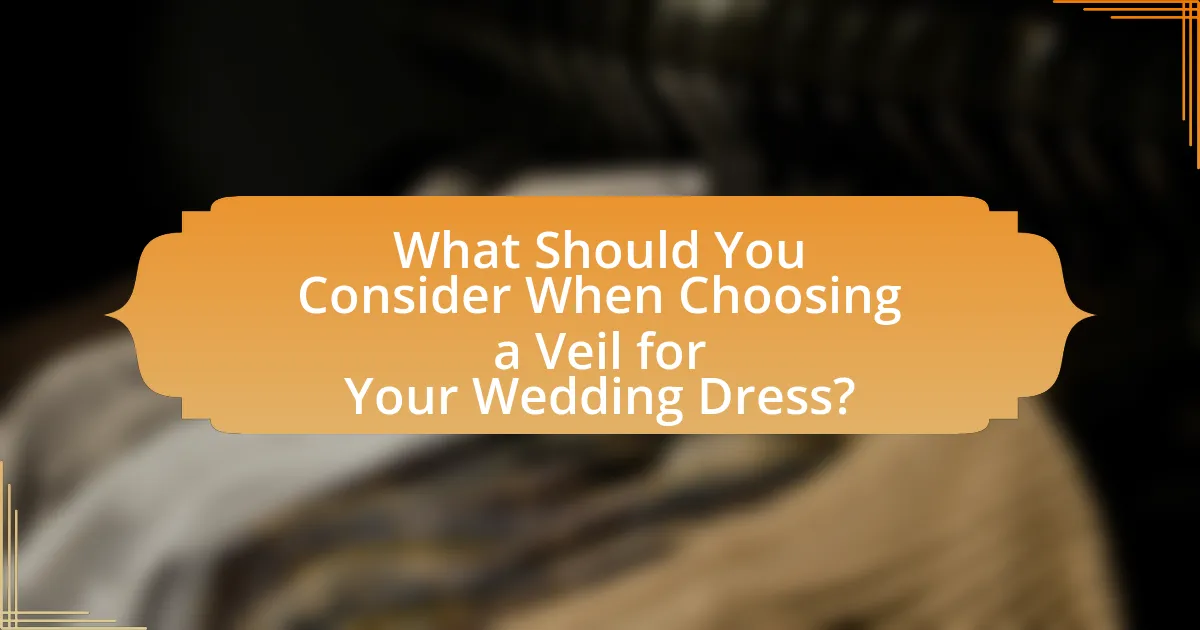
What Should You Consider When Choosing a Veil for Your Wedding Dress?
When choosing a veil for your wedding dress, consider the style, length, and fabric of the veil to ensure it complements your gown. The style of the veil should match the overall aesthetic of the dress; for example, a lace veil pairs well with a vintage gown, while a sleek, modern dress may suit a simpler veil. The length of the veil can vary from birdcage to cathedral, and it should be selected based on the dress’s silhouette and the desired look for the ceremony. Additionally, the fabric of the veil, such as tulle, lace, or silk, should harmonize with the materials of the wedding dress to create a cohesive appearance. These factors are essential in achieving a balanced and elegant bridal look.
How Does the Style of Your Wedding Dress Influence Veil Selection?
The style of your wedding dress significantly influences veil selection by determining the length, fabric, and embellishments that complement the overall look. For instance, a ball gown typically pairs well with a long, cathedral veil to enhance its dramatic silhouette, while a sleek, modern dress may be better suited to a shorter, simpler veil that maintains a streamlined appearance. Additionally, intricate lace details on a wedding dress often call for a veil with similar lace accents to create a cohesive aesthetic. This relationship between dress style and veil choice is essential for achieving a harmonious bridal look.
What Types of Wedding Dress Styles Pair Well with Different Veil Lengths?
A-line wedding dresses pair well with cathedral-length veils, creating a balanced silhouette that enhances the gown’s flow. Ball gown styles also complement cathedral veils, as the volume of the dress matches the dramatic length of the veil. For mermaid or fitted dresses, a shorter veil, such as a fingertip or elbow-length, works best, as it maintains the sleek lines of the gown without overwhelming it. Sheath dresses can be paired with various veil lengths, but a shoulder-length veil often adds a delicate touch without detracting from the dress’s simplicity. These pairings are based on traditional bridal styling principles that emphasize harmony between the dress and veil lengths.
How Do Fabric Choices in Your Dress Affect Veil Material Selection?
Fabric choices in your dress significantly influence veil material selection. For instance, if the dress is made of heavy fabrics like satin or brocade, a veil made from a lighter material such as tulle or lace can create a balanced look, allowing the veil to flow gracefully without overwhelming the dress. Conversely, if the dress features delicate fabrics like chiffon or organza, a veil made from similar lightweight materials will complement the overall aesthetic, ensuring harmony in texture and weight. This alignment between the dress fabric and veil material is essential for achieving a cohesive bridal appearance.
What Are the Different Types of Wedding Veils Available?
There are several types of wedding veils available, including the following: cathedral veils, which are long and dramatic, typically extending beyond the train of the dress; chapel veils, which are slightly shorter than cathedral veils and reach the floor; fingertip veils, which fall to the fingertips and are versatile for various dress styles; elbow veils, which reach the elbow and offer a more casual look; birdcage veils, which are short and often made of netting, providing a vintage feel; and blusher veils, which cover the face and are usually worn with another veil. Each type serves different aesthetic purposes and complements various wedding dress styles, allowing brides to choose based on their personal preferences and the overall theme of their wedding.
What Are the Characteristics of Cathedral, Chapel, and Fingertip Veils?
Cathedral, chapel, and fingertip veils are distinguished by their lengths and styles. Cathedral veils are the longest, typically extending beyond the train of the wedding dress, creating a dramatic effect. Chapel veils are shorter than cathedral veils, usually reaching the floor but not trailing significantly, offering elegance without overwhelming the gown. Fingertip veils are the shortest, designed to reach the bride’s fingertips, providing a more casual and modern look. Each veil type complements different dress styles and wedding themes, making them versatile choices for brides.
How Do Different Veil Styles Complement Various Wedding Themes?
Different veil styles enhance various wedding themes by aligning their design elements with the overall aesthetic of the event. For instance, a cathedral veil, characterized by its long length and dramatic appearance, complements formal or traditional weddings, adding elegance and grandeur. Conversely, a birdcage veil, which is shorter and often adorned with netting, suits vintage or retro-themed weddings, providing a playful yet sophisticated touch. Additionally, a lace-trimmed veil can enhance a romantic or bohemian theme, as the intricate details harmonize with soft, flowing wedding dresses. Each veil style serves to reinforce the chosen theme, creating a cohesive look that reflects the couple’s vision for their special day.
Why Is the Color of the Veil Important?
The color of the veil is important because it significantly influences the overall aesthetic and harmony of the bridal look. A veil that complements the wedding dress enhances the visual appeal and creates a cohesive appearance, which is essential for photographs and the ceremony. For instance, a white veil paired with a white dress maintains a classic bridal look, while a colored veil can add a unique touch and reflect the bride’s personality. Studies in fashion psychology indicate that color can evoke emotions and set the tone for the event, making the choice of veil color a crucial element in wedding planning.
How Can You Match the Veil Color to Your Dress?
To match the veil color to your dress, select a veil that complements the dress’s primary color. For instance, if your dress is white, a white veil will create a cohesive look. If your dress features ivory, a veil in a similar ivory shade will harmonize well. Additionally, consider the fabric and embellishments of the dress; a lace veil can enhance a lace dress, while a tulle veil may suit a simpler gown. This approach ensures that the veil enhances the overall aesthetic without clashing.
What Are the Trends in Veil Colors for Modern Weddings?
Modern weddings are seeing a trend towards a variety of veil colors, with soft pastels, bold hues, and even metallics gaining popularity. Brides are increasingly opting for veils in shades like blush, lavender, and champagne to complement their wedding themes and personal styles. Additionally, some are choosing vibrant colors such as deep red or royal blue to make a statement, while metallic veils in gold or silver add a contemporary twist. This shift reflects a broader movement in wedding fashion towards personalization and creativity, allowing brides to express their individuality through their choice of veil color.
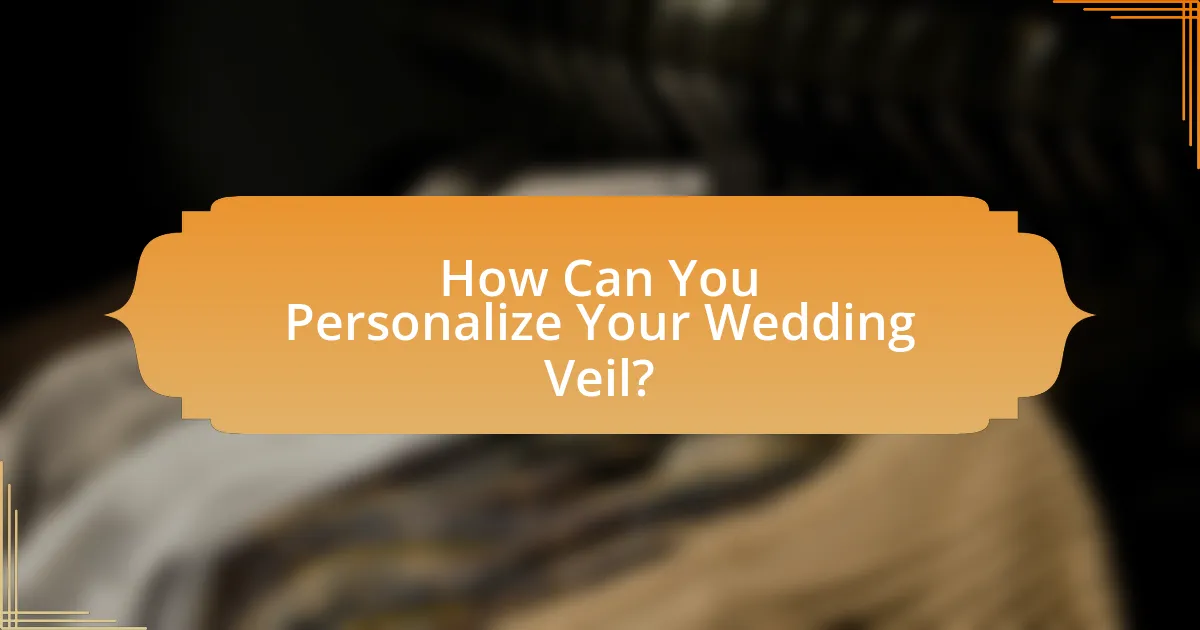
How Can You Personalize Your Wedding Veil?
You can personalize your wedding veil by incorporating unique elements such as custom embroidery, lace appliqués, or specific colors that reflect your wedding theme. Custom embroidery can include initials, wedding dates, or meaningful symbols, while lace appliqués can add texture and a personal touch. Additionally, selecting a veil color that complements your dress or represents your personality enhances its uniqueness. According to bridal fashion experts, personalized veils have become increasingly popular, with many brides opting for designs that tell their individual stories or honor family traditions.
What Embellishments Can Enhance Your Veil?
Embellishments that can enhance your veil include lace trim, beading, embroidery, and floral appliqués. Lace trim adds a delicate and romantic touch, often complementing the wedding dress’s design. Beading introduces sparkle and elegance, catching light beautifully during the ceremony. Embroidery can personalize the veil with intricate designs or monograms, making it unique to the bride. Floral appliqués provide a three-dimensional effect, adding texture and visual interest. These embellishments not only enhance the veil’s aesthetic but also create a cohesive look with the overall bridal ensemble.
How Do Lace, Beading, and Embroidery Affect the Overall Look?
Lace, beading, and embroidery significantly enhance the overall look of a wedding dress by adding texture, elegance, and visual interest. Lace introduces a delicate and romantic quality, often creating a vintage or ethereal appearance, while beading adds sparkle and dimension, drawing attention to specific areas of the dress. Embroidery contributes intricate designs that can personalize the gown, making it unique and reflective of the bride’s style. Collectively, these elements transform a simple dress into a statement piece, elevating its aesthetic appeal and ensuring it stands out on the wedding day.
What Are Some Unique Customization Options for Wedding Veils?
Unique customization options for wedding veils include varying lengths, fabric choices, and embellishments. Brides can select from options like fingertip, cathedral, or birdcage lengths to match their dress style. Fabrics such as tulle, lace, or silk allow for different textures and appearances. Additionally, embellishments like beading, embroidery, or floral appliqués can personalize the veil, making it a unique reflection of the bride’s style. Customization can also extend to color, with options ranging from traditional white to shades that complement the wedding palette.
How Can You Incorporate Family Heirlooms into Your Veil?
You can incorporate family heirlooms into your veil by attaching them as embellishments or integrating them into the design. For example, you might sew a piece of lace from a grandmother’s wedding dress onto the edge of your veil, or you could use a brooch from a family member as a decorative clasp. This practice not only personalizes the veil but also honors family traditions, creating a meaningful connection to your heritage on your wedding day. Historical examples show that many brides have successfully blended heirlooms into their attire, enhancing both the aesthetic and emotional significance of their wedding ensemble.
What Are Some Creative Ways to Use Vintage Fabrics or Accessories?
Creative ways to use vintage fabrics or accessories include repurposing them into unique wedding veils, creating custom bridal sashes, or crafting decorative elements for the wedding venue. For instance, vintage lace can be transformed into a delicate veil that adds a timeless touch to a wedding dress. Additionally, using vintage brooches or buttons as embellishments on a bridal gown or bouquet can enhance the overall aesthetic. These methods not only incorporate personal history but also contribute to sustainable fashion by giving new life to old materials.
How Can Personal Stories Be Reflected in Your Veil Design?
Personal stories can be reflected in veil design through the incorporation of meaningful symbols, colors, and materials that represent significant moments or relationships in one’s life. For instance, a bride may choose lace that resembles her mother’s wedding veil, symbolizing family heritage, or include embroidery that features a personal motto or date that holds special significance. Additionally, selecting colors that resonate with personal experiences, such as a shade that represents a cherished memory, can further personalize the veil. This approach not only enhances the aesthetic appeal but also imbues the veil with emotional depth, making it a unique representation of the bride’s journey.
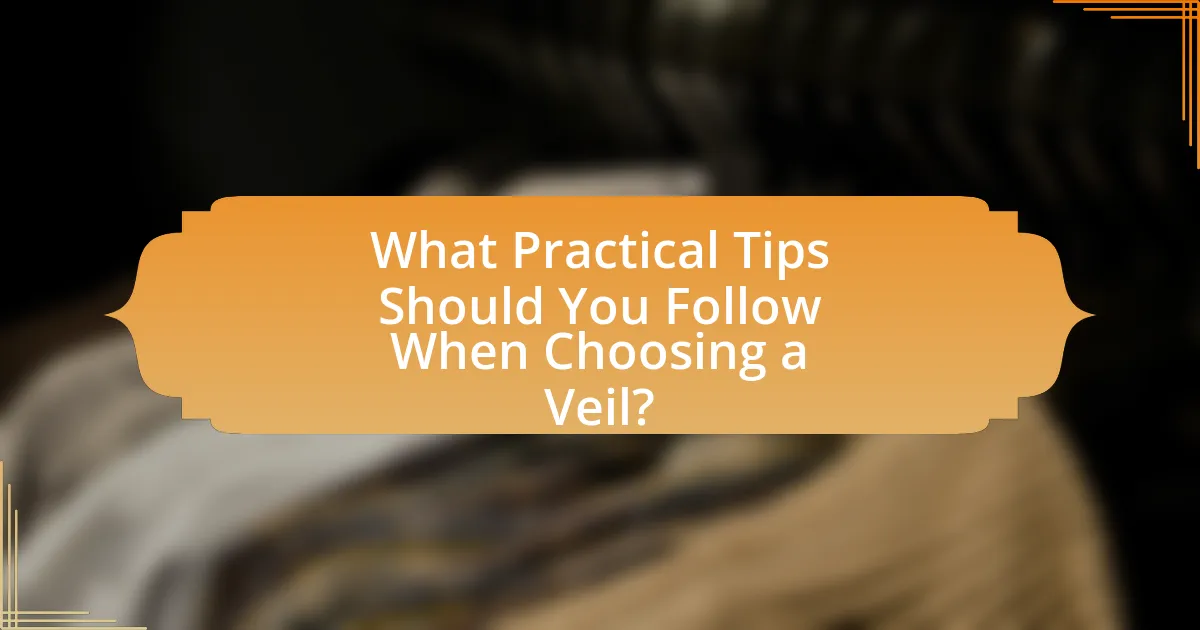
What Practical Tips Should You Follow When Choosing a Veil?
When choosing a veil, consider the length, style, and fabric to ensure it complements your wedding dress. The length of the veil should harmonize with the dress’s silhouette; for example, a long train may pair well with a cathedral veil, while a shorter dress might suit a birdcage or fingertip veil. The style of the veil should reflect the overall theme of the wedding; lace edges can enhance a vintage look, while a simple tulle veil can suit a modern aesthetic. Additionally, the fabric should match the dress material; silk veils work well with satin dresses, while tulle is versatile for various styles. These practical tips ensure that the veil enhances the bride’s overall appearance and fits seamlessly with the chosen gown.
How Do You Ensure Comfort and Functionality with Your Veil?
To ensure comfort and functionality with a veil, select lightweight materials such as tulle or chiffon that allow for breathability and ease of movement. These fabrics minimize discomfort during wear, especially for extended periods, and provide flexibility in styling. Additionally, consider the veil’s length and weight; shorter veils are generally easier to manage and less likely to cause strain. Proper attachment methods, such as using a comb or clips, enhance stability without compromising comfort. Research indicates that brides who prioritize these factors report higher satisfaction with their veil choices, leading to a more enjoyable wedding experience.
What Should You Consider Regarding Veil Weight and Attachment?
When considering veil weight and attachment, prioritize the balance between the veil’s heaviness and the hairstyle’s support. A heavier veil requires a more secure attachment method, such as combs or pins, to prevent slippage, while a lighter veil can be attached with simpler methods like hair clips. The attachment method must also complement the overall hairstyle to ensure stability throughout the event. For instance, a study by the Fashion Institute of Technology indicates that the weight distribution of a veil significantly affects its stability and the comfort of the wearer, emphasizing the importance of matching veil weight with appropriate attachment techniques.
How Can You Test the Veil’s Fit and Style Before the Wedding Day?
To test the veil’s fit and style before the wedding day, brides should schedule a fitting appointment with their bridal boutique or seamstress. During this fitting, the bride can try on the veil alongside her wedding dress to assess how well it complements the overall look. This process allows for adjustments to be made, ensuring the veil sits correctly and enhances the dress’s design. Additionally, taking photos during the fitting can help visualize how the veil will appear on the wedding day, providing a clearer perspective on its style and fit.
What Are Common Mistakes to Avoid When Selecting a Veil?
Common mistakes to avoid when selecting a veil include choosing a style that does not complement the wedding dress, neglecting to consider the wedding venue and theme, and failing to account for the veil’s length in relation to the bride’s height. Selecting a veil that clashes with the dress can detract from the overall look; for example, a heavily embellished veil may overwhelm a simple gown. Additionally, a veil that is too long or too short for the venue can create an unbalanced appearance. According to bridal experts, understanding the relationship between veil style, dress design, and the wedding setting is crucial for achieving a harmonious bridal look.
How Can You Prevent Mismatched Styles Between Your Veil and Dress?
To prevent mismatched styles between your veil and dress, ensure that both pieces share a cohesive design aesthetic. This can be achieved by selecting a veil that complements the dress’s fabric, embellishments, and overall silhouette. For instance, if your dress features intricate lace, choose a veil with similar lace detailing to create harmony. Additionally, consider the length and style of the veil; a long, flowing veil pairs well with a formal gown, while a shorter veil suits a more casual dress. Matching the color tones is also crucial; both the veil and dress should be in the same color family to avoid visual discord. By carefully coordinating these elements, you can achieve a unified look that enhances your overall bridal appearance.
What Should You Do If You Change Your Mind About Your Veil Choice?
If you change your mind about your veil choice, you should communicate your decision to your bridal consultant or designer as soon as possible. This allows for adjustments to be made, whether that involves selecting a different veil or modifying the existing one. Many bridal shops have return or exchange policies, which can facilitate this process, but it is essential to check the specific terms. Additionally, if the veil has already been customized or altered, discuss potential options for repurposing or selling it, as this can provide a solution if returning is not feasible.
